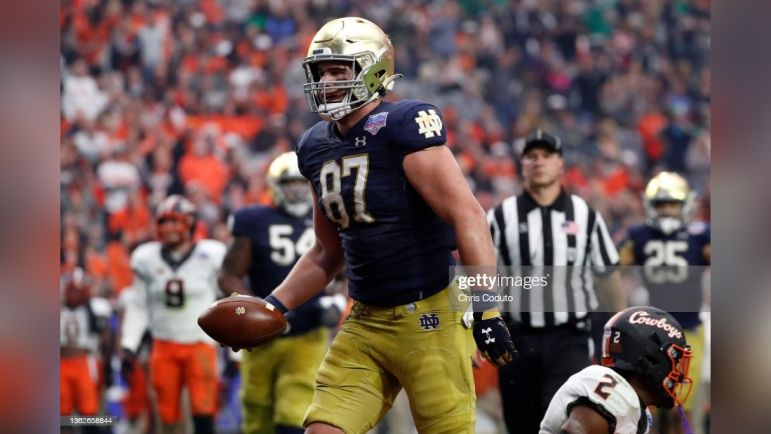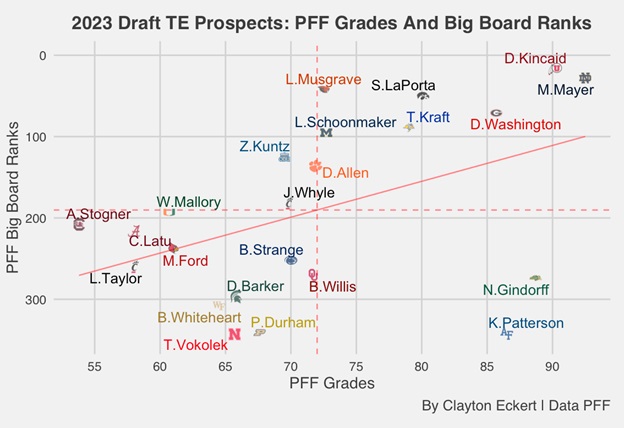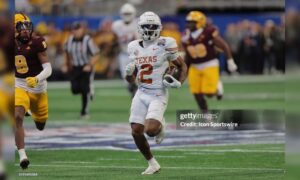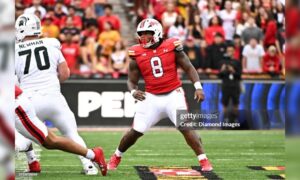Today I wanted to look at tight end prospects in the upcoming draft, a position that may become a need depending on how free agency unfolds for the Pittsburgh Steelers. The graph below uses their 2022 PFF Grade and their current rank on PFF’s Big Board that updates through the draft process:
The top overall player on PFF’s current board at the position is Utah’s Dalton Kincaid at number 17, who had increased snaps each of the last three seasons (633, 553, 99), playing 353 inline, 200+ in the slot, with 48 snaps out wide as well in 2022. He had 90+ overall and receiving grades, but a slightly above average 59.5 run block grade, along with a great 2.42 yards per route run, good 2.8% drop rate, and slightly above average 50% contested catch rate. Kincaid had two drops last season, an impressive 16 missed tackles forced (T-third), six deep catches (T-third), nine contested catches (T-seventh), 5.7 in YAC (T-73rd), 8.7 average depth of target (ADOT) that ranked 59th, and 187 deep yards (sixth). He expectedly increased his production each year, with 70 catches on 93 targets (75.3% catch rate) for 890 yards and eight touchdowns in 2022, compared to 36 catches on 45 targets (80% catch rate) with 510 yards and a matching eight touchdowns in 2021. Kincaid was a Senior Bowl and combine invite, but did not participate in either, recovering from injury.
Michael Mayer of Notre Dame saw his workload increase each of the last three years (748, 685, 442), playing 463 inline snaps, just over 200 in the slot, 63 out wide, and even 19 snaps in the backfield last season. He had 90+ overall and receiving grades, an excellent 82.1 run block grade, along with a great 2.44 yards per route run, slightly above average 5.6% drop rate, and a good 65.4% contested catch rate. Mayer had four drops, 12 missed tackles forced (T-eighth), topped the college football ranks with eight deep catches and 17 contested catches, had 4.9 in YAC (T-104th), an 8.1 ADOT (72nd), and 210 deep yards (third). His production was a bit better in 2021 in terms of catches (71) and yards (840) on 95 targets (74.7% catch rate), compared to last season: 67 catches on 101 targets (66.3% catch rate) but still eclipsed 800 yards, and improved his touchdown totals each year (nine, seven, two). It’s also important to note Pittsburgh had a formal meeting with him at the combine.
The first player that would start day two of the draft on PFF’s current board is Oregon State’s Luke Musgrave, who played the most in 2021 (643 snaps) compared to 300+ the previous season and only 114 last year, playing 80 snaps inline, 28 in the slot, and six out wide in 2022. He had a low 70 overall grade, upper 70 receiving grade, but low 54.3 run block grade, along with 3.38 yards per route run, an 8.3% drop rate, and 33.3% contested catch rate in only two games last season. Musgrave did not have big production as a receiver even in 2021, with 22 receptions on 37 targets (59.5% catch rate) for 304 yards and one touchdown his best marks when he played the most. He was a Senior Bowl participant and made my game notes as a run blocker, winning but also losing a rep, and had a nice catch over the middle for a first down.
Iowa’s Sam LaPorta saw the most opportunity in 2021 with 667 snaps, compared to 421 previously and 574 last season, when he had 350 inline snaps, 100+ in the slot, 86 out wide, and a high 28 in the backfield. He had a low 80 overall grade, a mid 80 receiving grade, but low 53.1 run block grade, along with a good 2.16 yards per route run, below average 9.4% drop rate and 37.5% contested catch rate. LaPorta had six drops, a whopping 20 missed tackles forced that ranked second in college football, two deep catches (T-40th), six contested catches (T-15th), 6.3 in YAC (T-56th), a 7.1 ADOT (104th), and 83 deep yards (T-38th). He was targeted more each year, with 58 receptions on 90 targets (64.4% catch rate) for 648 yards and a touchdown last season, compared to 53 catches on 81 targets (65.4% catch rate) for 670 and more touchdowns (three) in 2021, and 27 catches on 46 targets (58.7% catch rate) for 271 yards and one touchdown in 2020. LaPorta was a Senior Bowl invite but didn’t participate, though he did work out at the combine and met with the Steelers informally.
Darnell Washington of Georgia saw increased opportunity last season (555 snaps) after 200+ in each of the prior two years, playing 442 inline, 96 in the slot, 15 out wide, and one in the backfield in 2022. He had a mid 80 overall grade, a great 81.3 run block grade, a good upper 70 receiving grade, along with a good 1.77 yards per route run, average 6.7% drop rate, and slightly below average 40% contested catch rate. Washington had two drops, five missed tackles forced (T-45th), three deep catches (T-20th), two contested catches (T-86th), 7.2 in YAC (T-27th), a good 10.8 ADOT (T-17th), and 83 deep yards (T-38th), ranking in the top 100 across these stats. He was targeted 43 times in 2022 compared to 12 and 15 previously, with 28 catches last season (65.1% catch rate) for 454 yards and two touchdowns, and one touchdown the prior two years combined. Washington is coming off a great combine workout, confirming his well-documented great size and showcasing great speed for the position as well that will surely be intriguing to teams, likely moving him up the board.
South Dakota State’s Tucker Kraft saw the most opportunities by far in 2021 (656 snaps), compared to just 52 previously and 277 last season, when he played 195 inline snaps, 49 in the slot, 21 out wide, ten in the backfield, and even two at quarterback. He had an upper 70 overall grade, mid 70 receiving grade, a good 69.6 run block grade, along with a great 2.32 yards per route run, average 6.9% drop rate, but 0% contested catch rate. Kraft had two drops, nine missed tackles forced (T-19th), one deep catch (T-72nd), no contested catches, 7.7 in YAC (20th), a 6.2 ADOT (T-134th), and 36 deep yards (T-80th). In 2021 with substantial snaps, he had 65 catches on 84 targets (77.4% catch rate) for 770 yards and six touchdowns, compared to 27 receptions on 38 targets (71.1% catch rate) for 348 yards and three touchdowns on far less opportunity. Kraft is coming off a nice combine workout with good numbers across the board.
Luke Schoonmaker of Michigan had the most snaps in 2021 (504) compared to just 44 in 2020 and 470 last season, when he played 381 snaps inline, 66 in the slot, ten out wide, and even five at tackle along with eight as a fullback. He had a low 70 overall grade, upper 70 receiving grade, but below average 55.7 run block grade, along with a good 2.15 yards per route run, above average 5.4% drop rate, but poor 28.6% contested catch rate. Schoonmaker had two drops, just one missed tackle forced (T-137th), two deep catches (T-40th), two contested catches (T-86th), 5.4 in YAC (T-84th), a 7.8 ADOT (T-83rd), and 72 deep yards (48th). His targets nearly doubled from 2021 to last year on less snaps, posting 35 catches on 45 targets (77.8% catch rate) for 418 yards and three touchdowns in 2022, compared to 17 receptions on 23 targets (73.9% catch rate) for just 165 yards, but matched in touchdowns in 2021 with three. Schoonmaker was a Shrine Bowl invite but was dealing with injury, but able to work out at the combine with very strong numbers.
Now for players outside PFF’s top 100, starting with Old Dominion’s Zack Kuntz who played the most snaps in 2021 (627) with only 13 previously and just over 200 last season, when he had 111 inline, 70 in the slot, 24 out wide, and two in the backfield. He had an upper 60 overall grade, a 67.5 run block grade, and mid 60 receiving grade, along with an average 1.26 yards per route run, slightly below average 7.7% drop rate, and below average 33.3% contested catch rate. Kuntz had one drop, just one missed tackle forced (T-137th), no deep catches, two contested catches (T-86th), 3.8 in YAC (141st), a healthy 11.1 ADOT (T-14th), but no deep yards. In 2021 when he had substantial snaps, he posted 73 catches on 112 targets (65.2% catch rate) for 692 yards and five touchdowns, compared to 12 catches on 28 targets for a low 42.9 catch rate, 144 yards and two touchdowns in 2022. Kuntz worked out at the combine, posting a perfect RAS score and garnered interest from Pittsburgh with an informal meeting.
Clemson’s Davis Allen saw an increased workload each of the last three years (596, 495, 287), providing 329 inline snaps, 213 in the slot, 46 out wide, and even seven as a fullback and one snap at tackle in 2022. He had low 70 overall and receiving grades, a good 69 run block grade, along with and above average 1.57 yards per route run, good 2.5% drop rate, and a great 91.7% contested catch rate. Allen had one drop, two missed tackles forced (T-107th), four deep catches (T-12th), a strong 11 contested catches (T-3rd), five in YAC (T-100th), a 9.1 ADOT (T-44th), and 114 deep yards which ranked 17th. Allen’s targets increased each season (51, 38, 20) as well as his receptions and yards, with 39 catches in 2022 (76.5% catch rate) for 443 yards and five touchdowns, compared to a 73.7% catch rate for 208 yards and three touchdowns in 2021, and catching 16 of his 20 targets in 2020 (80% catch rate) for 247 yards and four touchdowns. Allen was a Senior Bowl participant, making my game notes with good run blocking on two occasions, with one being a nice combo block, and also worked out at the combine.
Josh Whyle of Cincinnati had more opportunities in each of the last three seasons (610, 460, 222), playing 352 inline snaps, 181 in the slot, 31 out wide, and a whopping 46 in the backfield as a fullback in 2022. He had upper 60 overall, receiving, and good run block grades, along with a below average 1.11 yards per route run, good 3% drop rate, but poor 28.6% contested catch rate. Whyle had one drop, two missed tackles forced (T-107th), no deep catches, two contested catches (T-86th), 5.2 in YAC (T-91st), an ADOT of eight (T-73rd), and no deep yards. His targets increased each season as expected (51, 40, 34), but yards slightly declined (326, 330, 353) along with his catch rates (62.7, 65, 82.4), and particularly had a drop off in touchdowns (three, six, six). Whyle had a strong overall game at the Senior Bowl in my opinion, with several positives in my notes including a few strong run blocks (one great one), showing ability as a receiver and getting wide open against zone coverage on a rep along with a quality pass block, but lost two pass block reps, one leading to a scramble and another coming from a fullback alignment, and also participated in the combine.
Next, I would like to give context on two players that are day three options on PFF’s current big board that had above the mean grades. North Dakota State’s Noah Gindorff had the most snaps in 2021 (443), with 360 previously, but had only 81 snaps in 2022, when he played 70 inline, six in the slot, two out wide, two at tackle and one at fullback. He had upper 80 overall and receiving grades, a 73.5 run block grade, along with 2.24 yards per route run, a 0% drop rate, and no contested catches in his three games played last season. Even when Gindorff played more, he wasn’t targeted very often, with 26 in 2021 when he had 17 catches (65.4% catch rate) for 193 yards and two touchdowns, and 23 targets with only 11 catches (47.8% catch rate) but did provide his best touchdown production (three). Gindorff was a combine invite, confirming great size at the position.
Air Force’s Kyle Patterson had a slight decrease in opportunities each of the last three years (206, 232, 291), playing 119 inline snaps, 25 in the slot, 52 out wide, and even eight at tackle along with two at fullback last season. He had mid 80 overall and great run blocking grades, but a mid 60 receiving grade, along with 1.68 yards per route run, a poor 25% drop rate, and 50% contested catch rate. Patterson was seldomly used as a receiver with only three catches in each of the last two seasons and 12 in 2020 when he had his only notable production (205 yards and two touchdowns), and only 33 total targets over the three-year span. Patterson was a combine invite, another player with good size for the position.
Now for some more late round prospects on PFF’s current big board with below average grades, and I will discuss some of them. Miami’s Will Mallory had the most opportunity in 2021 (779 snaps), compared to 464 previously and 639 last season, when he provided 421 inline, 188 in the slot, 17 out wide, and even three at tackle along with ten at fullback. He had a low 60 overall grade, an upper 70 receiving grade, but very poor 36.6 run block grade, along with a good 1.68 yards per route run, an above average 4.5% drop rate, but below average 38.5% contested catch rate. Mallory had two drops, seven missed tackles forced (T-30th), three deep catches (T-20th), five contested catches (T-26th), 7.2 in YAC (T-27th), a 6.9 ADOT (T-109th), and 98 deep yards (29th), solid ranks aside from ADOT. He had more receptions (42, 30, 22), targets (59, 43, 30), and yards (542, 347, 329) each season, and improved his catch rate on more volume last year (71.2, 69.8, 73.3) but a slight fall in touchdown production (three, four, four). Mallory was a Senior Bowl participant, and had a strong game particularly as a receiver, with several catches including two over the middle, one including YAC for a first down, along with a win as a run blocker. He was also a combine participant, a smaller prospect that tested very well otherwise.
Alabama’s Cameron Latu saw increased opportunities each season (665, 523, 55), playing 390 inline snaps, 196 in the slot, 59 out wide, and even five at tackle and 15 at fullback in 2022. He had a high 50 overall grade, low 60 receiving grade, but poor 50 run block grade, along with a below average 1.03 yards per route run, below average 9.1% drop rate, and slightly below average 40% contested catch rate. Latu had three drops, two missed tackles forced (T-107th), two deep catches (T-40th), two contested catches (T-86th), 4.2 in YAC (T-127th), a 9.8 ADOT (T-29th), and 61 deep yards (56th). He had 30 catches on 49 targets (61.2% catch rate) for 376 yards and four touchdowns last season, compared to more production on less opportunity in 2021, when he had 26 catches on 38 targets (68.4% catch rate) for 409 yards and twice as many touchdowns (eight). Latu was a Senior Bowl participant, making my game notes with a few short catches, providing a catch and run for a first down, and winning a run block rep but had a poor one as well. He was a combine invite as well, weighing in on the small side at the position.
Brenton Strange of Penn State had increasing snap counts each of the last three years (584, 580, 430), playing 292 inline, 176 in the slot, 26 out wide, and a whopping 90 in the backfield, mostly at fullback and even 21 at halfback in 2022. He had a 70 overall grade, low 70 receiving grade, and above average 60.5 run block grade, along with an above average 1.45 yards per route run, a good 3% drop rate, and good 62.5% contested catch rate. Strange had one drop, seven missed tackles forced (T-30th), two deep catches (T-40th), five contested catches (T-26th) 7.3 in YAC (T-25th), a 5.2 ADOT (T-151st), and 92 deep yards (T-32nd), solid ranks aside from ADOT. Though the volume wasn’t overwhelming, his is production increased in many ways each season, including catches (32, 20, 17), targets (38, 34, 20), yards (362, 225, 164), and touchdowns (five, three, two), along with strong catch rates with 2021 being the exception (84.2, 58.8, 85). Strange was a combine invite, fitting the size Pittsburgh looks for and had a good overall workout, and notably met with Steelers position coach Alfredo Roberts.
Cincinnati’s Leonard Taylor had the most snaps in 2021 (494) compared to 279 previously and 440 last season, when he had 363 inline snaps, 67 in the slot, six out wide, and four at fullback. He had upper 50 overall and receiving grades, a below average 54.1 run block grade, along with a low 0.94 yards per route run, and a 5.3% drop rate. Leonard had one drop, three missed tackles forced, one deep catch, one contested catch, 2.9 in YAC, a 7.3 ADOT, and 21 deep yards. His best receiving production came in 2021 on a bit more opportunity than last year, when he was targeted the most by far (45) with 28 catches (62.2% catch rate) for 272 yards and four touchdowns, compared to 2020 when he had 24 targets and 16 catches (66.7%) for 191 yards and one touchdown, then 23 targets and 18 catches for a much improved 78.3% catch rate for 170 yards and two touchdowns last season. Taylor was a Shrine Bowl participant that our own Melanie Friedlander noted as sticking out, but caveating the talent bar at the position being low at the event, showing strength and well-roundedness, with pass blocking being a personal growth goal, and stating Taylor could make sense as a late or undrafted option for Pittsburgh. He was also a combine invite, meeting the size thresholds Pittsburgh typically looks for.
Daniel Barker of Michigan State had 350+ snaps each of the last three years (353, 399, 387), playing 230 inline, 75 in the slot, 16 out wide, and 32 in the backfield including two at halfback. He had a mid 60 overall grade, high 60 receiving grade, low 60 run block grade, along with an above average 1.41 yards per route run, but very poor 16% drop rate and poor 25% contested catch rate. Barker had four drops, two missed tackles forced (T-107th), no deep catches, three contested catches (T-56th), 4.2 in YAC (T-127th), and 8.9 ADOT (T-51st), and no deep yards. He had targets in the 30’s each year (39, 31, 33), with similar catch totals (21, 18, 19), yards (239, 202, 268), and touchdowns (two, four, two), though his catch rate dipped last season on a bit more opportunity (53.8, 58.1, 57.6). Barker was a Shrine Bowl participant, making my game notes with a short catch and winning a run block.
Wake Forest’s Blake Whiteheart saw an increased workload each season (648, 558, 244), playing 540 snaps inline, 96 in the slot, and 12 at fullback, with none out wide. He had a mid 60 overall and good run block grade, a low 60 receiving grade, along with a below average 0.97 yards per route run, with a 0% drop rate, and good 70% contested catch rate. Whiteheart had no drops, two missed tackles forced (T-107th), four deep catches (T-12th), and also ranked well with seven contested catches (T-11th), but 2.5 in YAC (T-166th), a very strong 13.5 ADOT (T-second), and 101 deep yards (27th). He provided increased production each season in targets (35, 21, seven), catches (24, 15, five), yards (295, 185, 61), with 68.6% catch rate in 2022 after posting 71.4% in the prior two years, along with three touchdowns in each of the last two seasons. He was a Shrine Bowl invite and didn’t have any notes on him, but caught the Steelers eye considering their informal meeting with him at the combine.
Payne Durham of Purdue was provided with more opportunities each year (785, 509, 402), playing 435 inline snaps, 325 in the slot, 13 out wide, nine at fullback, and even three at tackle. He had and upper 60 overall grade, 70+ receiving grade, but slightly below average 56.7 run block grade, along with an average 1.23 yards per route run, a good 3.4% drop rate, and above average 57.1% contested catch rate. Durham had two drops, a good 10 missed tackles forced (T-10th), no deep catches, a strong eight contested catches (T-ninth), 4.7 in YAC (T-112th), a 7.2 ADOT (T-101st), and no deep yards. His receiving production increased each season across the board: targets (77, 59, 26), catches (56, 45, 16), yards (560, 467, 166), and touchdowns (eight, six, three), along with solid catch rates the last two years given the volume (72.7, 76.3, 61.5). Several of our Steelers Depot crew that went to the Senior Bowl enjoyed what they saw, and Durham made my game notes with a nice run block, scored on a two-point conversion from a fullback alignment, where he also had a carry for a short gain, and made another nice catch on a throw that was behind him, and was also a combine invite.
The final player at the position on PFF’s current big board is Nebraska’s Travis Vokolek who also saw an increase in snaps each season (470, 342, 310), playing 267 inline, 99 in the slot, a whopping 90 snaps at tackle, along with seven out wide and at fullback. He had mid 60 overall and good run blocking grades, a 60+ receiving grade, along with a below average 1.05 yards per route run, but poor 13% drop rate and 0% contested catch rate. Vokolek had three drops, four missed tackles forced (T-62nd), no deep or contested catches, 6.9 in YAC (T-35th), a 7.2 ADOT (T-101st), and no deep yards. His receiving opportunities increased a bit last season, when he had 20 catches on 33 targets (60.6% catch rate) for 240 yards and two touchdowns, matching his catch totals in the previous two years combined, surpassing those yardage totals, and posting a 60.6% catch rate last year. Vokolek was a Shrine Bowl participant, with Friedlander noting his good end to the week, showcasing good separation and hands, liking him as a Pittsburgh candidate, with my only note on him from the game coming on a holding penalty on a run play. He was also invited to the combine, weighing in with solid height/weight the Steelers typically covet.
There were a couple names that were left off of PFF’s current draft board I wanted to mention. USC’s Josh Falo was a late addition to the Shrine Bowl, and had a couple nice over the middle catches, and seems to have the height/weight the Steelers look for, but will have to wait on a hopeful pro day workout since he was not invited to the combine. Joel Wilson of Central Michigan was also at the Shrine Bowl, but thought he really struggled in the game particularly with two passes going off his hands and interceptions, along with losing a run and pass block rep, but did note one good run block.
It will be interesting to see how the position room unfolds for the Steelers, and if any additions are made in the 2023 NFL draft. While the ranks on PFF’s board will certainly change, and surely some names missing from this list, I hope you enjoyed and learned something from the grade data and notes from the all-star games.
What are your thoughts on this year’s prospects and the data? Thanks for reading and let me know your thoughts in the comments.









